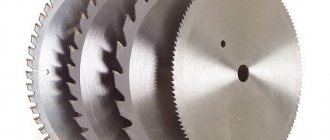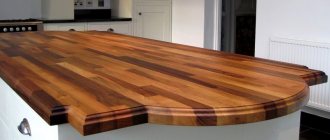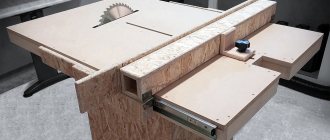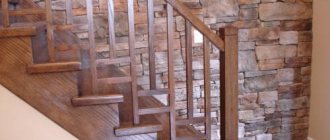Anyone who has worked with a hand-held circular saw at least once knows how difficult it is to make a clear and even cut with it. Many solve this problem with the help of simple devices, such as a strip of plywood or plastic, which is fixed to the surface with clamps. However, it is much more convenient to use a special guide rail for this purpose.
Such a device is very rarely included in the package of a hand-held circular saw, and in stores it is offered at a price often comparable to the cost of the saw itself. This seems strange, because it is not distinguished by the complexity of its design. If you have the necessary materials, it is quite possible to make a guide bar yourself, which we will discuss in this article.
What it is?
Essentially, a guide bar is a rail that allows a hand-held circular saw to slide forward and backward while preventing the tool from deviating from the cutting line. But a properly designed guide not only ensures an even cut, it also reduces the number of chips where the saw and the material come into contact.
Homemade guides have different designs and are made from different materials. Eg:
- plywood guide;
- rail miter box from a corner;
- aluminum profile tire;
- ruler from the building code;
- external carriage on bearings.
The miter box and remote carriage are the most difficult to manufacture. A plywood guide or profile rail is much simpler in design, but this does not mean that the cut made with their help will not be of such high quality. The difference between these varieties largely lies in ease of use.
Purpose of the guide bar
specialized guides for specific saw models
Anyone who has worked with a circular saw knows how difficult it is to get it straight. No matter how hard you try to guide the tool clearly along the markings, it still tends to move to the side. The result is material damage and waste of time.
Some craftsmen adapt this way: they fasten the bar along a ruler with a pair of clamps. However, with a manual circular saw this method is inconvenient - the clamps touch the tool. There are several other reasons for using a guide bar:
- When using a rule, it is necessary to correct its position all the time. It is installed with a slight indentation from the cutting line, only then the disc will accurately follow the line. This method will work for single jobs. If you need to make a lot of precise cuts, the process is tedious;
- The proprietary circular saw guide is designed so that its edge clearly coincides with the cutting line. The master only needs to combine these two stripes and work;
- high-quality tires are additionally taped with a soft tape that prevents chipping of the material, for example, MDF or laminate;
- It is inconvenient to saw and monitor the location of the rule at the same time. A little too much or too little, and the material is ruined. When working with the bar, you only need to move the saw forward.
There are many types of guide bars on sale: universal or specialized for a specific model or manufacturer. The price of universal devices is usually higher than specialized ones. Therefore, many home craftsmen make tires with their own hands.
From plywood
This is one of the simplest universal guide options for a hand-made circular saw, and therefore it is most common in home workshops. Let us consider in detail the process of its manufacture and the principle of operation.
Necessary materials
To make such a tire you will need three pieces of plywood 10 mm thick. Their length should be the same and is usually equal to the length of the workbench on which the work will be done. One of the segments should be 25-35 cm wide (it will serve as the base), the width of the other two will be determined during the manufacture of the tire. Also prepare 16 mm wood screws.
Drawing with dimensions:
Manufacturing instructions
When creating a guide, all dimensions must be observed very accurately. Small deviations can lead to a sharp deterioration in the result. If desired, laminate can be used instead of plywood.
The plywood guide rail is made in several steps:
- Measure the distance from the inner edge of the saw blade to the rip guide groove located on the tool support platform.
- Cut one of the plywood strips so that its width is 0.2-0.5 mm less than the distance obtained in step 1. The grains of the top layer of veneer on plywood should be directed longitudinally.
- Using self-tapping screws, screw the resulting strip to a wide piece of plywood (base), precisely aligning their ends. This will be the working edge of the tire.
- Using a caliper, measure the width of the longitudinal cut guide groove.
- Screw the remaining strip of plywood to the base parallel to the first strip. There should be a gap between them, the size of which should be 0.2-0.5 mm less than the width of the groove measured in the previous paragraph.
- To avoid damaging the material being cut, a layer of soft fabric is glued to the finished guide on the bottom side.
Important: before measuring the soleplate of a circular saw, be sure to disconnect it from the power supply!
The homemade guide is ready, all that remains is to prepare the hand saw. To do this, saw off a narrow strip of thick plywood or other sufficiently durable material. The height of this strip should be 8-9 mm greater than the depth of the guide groove on the saw base. The width corresponds to the width of this groove. The length is several centimeters longer than the length of the sole.
Making a tire with your own hands
The main task is to make a geometrically accurate product with your own hands, which is not easy. I would like to make a convenient and reliable device, spending a minimum of time.
The following can be used as a base: a channel, a corner, a rectangular pipe and even a laminate. Wooden and pressed guides have a serious drawback - they are sensitive to moisture.
Option 1
The guide rail is made of laminate - the simplest and most affordable material.
- We cut two pieces of laminate of the same length along a ruler (for example, 50 cm).
- We mill one edge at a time.
- We attach it with self-tapping screws to the base, also made of laminate.
- The width of the groove is checked using a sheet of A4 paper, approximately 0.11 mm thick: the paper is inserted into the device and screwed.
- The guide is fixed to the sole of the circular saw with your own hands through the mount for the side stop. You can drill a special hole in the case, if you don’t mind and the warranty period has passed.
- When working with the guide bar, it should be extended as far as possible in front of the hand-held circular saw. And the nose of the sole should extend a few centimeters onto the guide. Now let’s take a disk for sawing laminate and saw off the edges of the guides on the spot so that they align perfectly with the markings;
This device eats up the cutting depth a little (by about 1.5 cm), but it is very convenient and easy to do with your own hands.
Option 2
Now let's take the construction rule as the basis for the tire. A model with handles that move along a groove is suitable.
- We remove the handles and instead select soft-locking clamps with spring handles. There are models with a removable top - they are just right. Having removed it, the clamp is fixed to the rule using an adapter.
- The adapters will have to be made yourself from polypropylene on a milling machine. As a result, you should get parts that resemble the letter “T” in cross-section; they are tightly inserted into the groove for the handles.
- We make holes in the “leg” of the adapters and screw clamps onto the screws.
- The guide is placed on a sheet of material with the groove down and securely pressed with clamps from below. There is not a single part on top that slows down the operation of the circular saw. There is only one limitation in the work - the length of the rule, so you need to take the longest one.
rule profile
clamps
guide assembly
Other types
If for some reason the plywood rail does not meet your requirements, you can make the guide of a more complex design. Below are a few more examples of guides for a manual circular saw that anyone can make with their own hands.
Aluminum profile tire
This type of tire differs from a simple plywood tire in that a U-shaped aluminum profile is installed in the guide gap. Its advantage is that the rigidity of aluminum slightly increases the cutting accuracy.
For better sliding of the saw along the bar, as limiters, you can attach not thick plywood to the guide groove of the sole, but a pair of cylinders of suitable height made of fluoroplastic or other material with a low coefficient of friction.
Ruler from a building code
There are long aluminum rules that are used by finishers to level walls. To make a guide ruler with your own hands, rules are suitable, the design of which provides a groove for the free movement of the handles.
The main advantage of such a line is the absence of elements protruding above the surface of the workbench. To do this, you need to take two collapsible clamps and slightly modernize them.
The handles are removed from the rule, and their upper parts from the clamps, which are replaced with polypropylene or fluoroplastic inserts. The profile of these inserts must be T-shaped so that they can be installed with the wide part into the rule groove and be held there.
The result is a ruler that is attached to the workbench only at the bottom. This will allow you to move the saw freely in the work area without fear of getting caught on something.
However, such a tool cannot be called a full-fledged tire. This is the ruler that needs to be adjusted before each cut.
Rail miter box
This device is most often used for cross cutting (trimming) of material.
Usually it consists of two parallel metal corners, the ends of which are rigidly fixed to a plywood or metal base.
The saw platform moves freely along the corners, as if on rails.
The corners are secured with bolts or studs, which are also used to adjust the height of the “rails” relative to the base. The height should be such that the material to be cut fits freely under the corners.
To make the saw movement smoother, the corners on the inside can be glued with a material with a high slip coefficient. For even smoother movement, you can install the saw sole on a platform with metal wheels.
External carriage on bearings
A circular saw on an external carriage is more like a stationary format-cutting machine. This design is highly stable and, accordingly, provides high cutting accuracy.
The remote carriage is made of a metal I-beam, which is firmly attached with its lower plane to the workbench. The carriage itself moves along the upper plane - a platform, the lower edges of which are bent inside the I-beam and are equipped with bearings that allow it to slide freely. These same bearings, tightly pressed to the I-beam axis, eliminate lateral play of the carriage.
Homemade tabletop mini sawmill
A hand-held circular saw is a must-have tool in the home workshop of a self-respecting owner. To work successfully, it must have a circular saw guide bar. Saw blades are of considerable importance; the quality and accuracy of cutting depends on their thickness and the size of the teeth. The smaller the tooth, the cleaner the surface being processed will be.
A well-equipped workshop has hand-held power tools that have a circular saw guide bar, made and set up for successful work. As well as a special connection for a vacuum cleaner and bags or containers for sawdust. This is a very practical solution, because during long sawing you won’t have to stop every minute to clean the work area. This saw is produced by Bosch for professionals. In addition, it has the ability to adjust the angle of deviation from the vertical and the cutting depth.
Choosing the right tool
Before purchasing, you should make sure that the selected tool provides the required cutting depth vertically and at an angle. An additional aspect that can make normal operation easier is the length of the cable. If conditions are not favorable for using an extension cord, you should choose a saw with a long cord.
The saws offered by well-known manufacturers are equipped with a device for easy replacement of discs, which further simplifies the work. This is an excellent electric tool that can be used for minor repairs around the house or garden.
For those people who love to tinker, this mechanism is simply necessary. Thanks to its small size, there is always a place for it even in a small home workshop.











